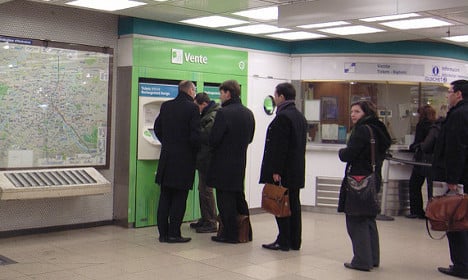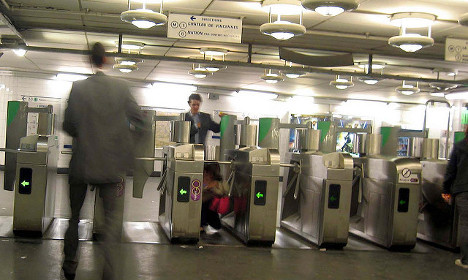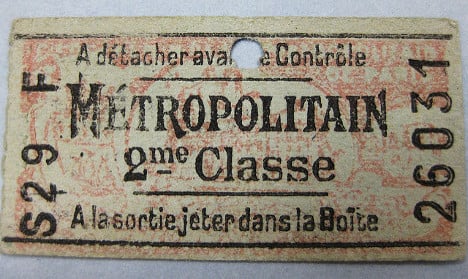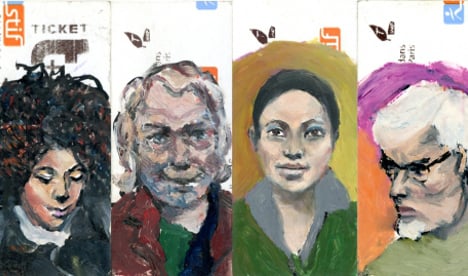Say 'au revoir' to the Paris Metro ticket

As part of a comprehensive modernization of the capital’s transport system, the emblematic Parisian Métro ticket will soon be a thing of the past.
For nearly 116 years, from the opening of the first line in 1900, those little rectangles of white paper with a black line on the back - the tickets for a ride on the Paris Metro system, have been with us.
Sure, sometimes it can be a pain having to rummage through your pockets or the depths of your bag to find the tiny tickets during a random check or when you unexpectedly need it to get out of the station. But it's just a part of life in Paris, right?
But not for much longer.
Valérie Pécresse, president of the Ile de France region around Paris, has decided the Métro tickets, which are also used on the city's buses, will be no more. By 2021 they will be a mere memory.
In an interview with Le Journal du dimanche, she outlined a plan to modernize the region’s transport system over the next several years, soon to be presented to the the Ile-de-France transport union.
 Photo: Nicolas Nova/Flickr
Photo: Nicolas Nova/Flickr
So what exactly is going to change?
Well, for starters it won’t happen overnight.
Instead, measures will be taken to gradually replace the traditional Métro and bus ticket. To start, the monthly Navigo pass, which is used on Metro, trains and buses in the Paris region, will be renamed “smart Navigo” and will move right into your smartphone. So instead of the card, you’ll just scan your phone at the ticket barrier.
For occasional travelers, an anonymous and re-chargeable “transport wallet” will be available, to be debited throughout their journey - a bit like the Oyster card in London.
Pécresse also hopes that travelers will be able to pay for their journey directly with contactless bank cards. 60 percent of cards in France already use this technology, so it wouldn’t be a hugely difficult switch.
Another potential project is to put in place an “intelligent deferred payment system” that would give travellers the best deal according to their transport use. So you’d be billed monthly for the transport you actually used.
 Photo: Michelle Kinsey Bruns/Flickr
Photo: Michelle Kinsey Bruns/Flickr
These modifications wouldn’t just affect the Métro but ideally would also extend to the Vélib bicycle rental system, Autolib, parking lots, and even taxis and carpooling.
It's true that these steps will probably make life easier for those traveling in the Paris region, but that doesn’t mean we can’t get a bit sentimental about the disappearance of that little ticket that has been with us for so long.
In memory, here are a few things you might not know about the Paris Métro ticket.
It’s been all sorts of colors
It’s been white since 2007, but the Paris Métro ticket has seen many colors of the rainbow including red, yellow, green, orange and purple.
But its shape has always stayed the same.
Until 1991, you could buy first-class Métro tickets
 Photo: Naval History & Heritage Command/Flickr
Photo: Naval History & Heritage Command/Flickr
In 1900, you would pay 15 cents (of France’s previous currency, the franc) for a second-class ticket and 25 cents for first-class. These days everyone is in the same class and you’ll pay €1.80 for a single journey or €14.10 for a book of ten.
They’ve been made into works of art
 Photo: Luc Grateau
Photo: Luc Grateau
French Painter Luc Grateau painted tiny portraits on Métro tickets, building up a series of more than 2,000 portraits from six years of Métro commuting.
Some have put their origami skills to use by transforming the tickets into the X-wing fighter ships from Star Wars.
They’ve gotten makeovers for specific, important events
The Métro tickets have been redesigned many times over the years, but they’ve even gotten temporary makeovers for special occasions, such as the Europride LGBT event in 1997.
Whether you’ll miss it or you’ll be happy to see it go, there’s no denying that the Métro ticket has been a significant and indelible part of Parisian culture.
By Katie Warren
Comments
See Also
For nearly 116 years, from the opening of the first line in 1900, those little rectangles of white paper with a black line on the back - the tickets for a ride on the Paris Metro system, have been with us.
Sure, sometimes it can be a pain having to rummage through your pockets or the depths of your bag to find the tiny tickets during a random check or when you unexpectedly need it to get out of the station. But it's just a part of life in Paris, right?
But not for much longer.
Valérie Pécresse, president of the Ile de France region around Paris, has decided the Métro tickets, which are also used on the city's buses, will be no more. By 2021 they will be a mere memory.
In an interview with Le Journal du dimanche, she outlined a plan to modernize the region’s transport system over the next several years, soon to be presented to the the Ile-de-France transport union.
 Photo: Nicolas Nova/Flickr
Photo: Nicolas Nova/Flickr
Well, for starters it won’t happen overnight.
Instead, measures will be taken to gradually replace the traditional Métro and bus ticket. To start, the monthly Navigo pass, which is used on Metro, trains and buses in the Paris region, will be renamed “smart Navigo” and will move right into your smartphone. So instead of the card, you’ll just scan your phone at the ticket barrier.
For occasional travelers, an anonymous and re-chargeable “transport wallet” will be available, to be debited throughout their journey - a bit like the Oyster card in London.
Pécresse also hopes that travelers will be able to pay for their journey directly with contactless bank cards. 60 percent of cards in France already use this technology, so it wouldn’t be a hugely difficult switch.
Another potential project is to put in place an “intelligent deferred payment system” that would give travellers the best deal according to their transport use. So you’d be billed monthly for the transport you actually used.
 Photo: Michelle Kinsey Bruns/Flickr
Photo: Michelle Kinsey Bruns/Flickr
These modifications wouldn’t just affect the Métro but ideally would also extend to the Vélib bicycle rental system, Autolib, parking lots, and even taxis and carpooling.
It's true that these steps will probably make life easier for those traveling in the Paris region, but that doesn’t mean we can’t get a bit sentimental about the disappearance of that little ticket that has been with us for so long.
In memory, here are a few things you might not know about the Paris Métro ticket.
It’s been all sorts of colors
It’s been white since 2007, but the Paris Métro ticket has seen many colors of the rainbow including red, yellow, green, orange and purple.
But its shape has always stayed the same.
Until 1991, you could buy first-class Métro tickets
 Photo: Naval History & Heritage Command/Flickr
Photo: Naval History & Heritage Command/Flickr
In 1900, you would pay 15 cents (of France’s previous currency, the franc) for a second-class ticket and 25 cents for first-class. These days everyone is in the same class and you’ll pay €1.80 for a single journey or €14.10 for a book of ten.
They’ve been made into works of art
 Photo: Luc Grateau
Photo: Luc Grateau
French Painter Luc Grateau painted tiny portraits on Métro tickets, building up a series of more than 2,000 portraits from six years of Métro commuting.
Some have put their origami skills to use by transforming the tickets into the X-wing fighter ships from Star Wars.
They’ve gotten makeovers for specific, important events
The Métro tickets have been redesigned many times over the years, but they’ve even gotten temporary makeovers for special occasions, such as the Europride LGBT event in 1997.
Whether you’ll miss it or you’ll be happy to see it go, there’s no denying that the Métro ticket has been a significant and indelible part of Parisian culture.
By Katie Warren
Join the conversation in our comments section below. Share your own views and experience and if you have a question or suggestion for our journalists then email us at [email protected].
Please keep comments civil, constructive and on topic – and make sure to read our terms of use before getting involved.
Please log in here to leave a comment.